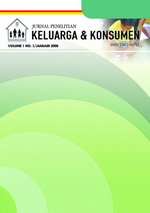PERAN STIMULASI ORANGTUA TERHADAP PERKEMBANGAN ANAK BALITA KELUARGA MISKIN
Abstract
Parents have an important role in childcare. Not all parents, especially fathers are able to practice child caring in proper and adequate way. The objective of this research was to analyze relationship of stimulation given by parents to the development of their children. The research was carried out in surrounding Bogor Agricultural University (IPB) Darmaga Campus. Samples consisted of two groups of children, 37 normal and 37 stunting were drawn randomly from the participants of World Food Program (WFP) feeding project in Bogor District. Data were collected from April to May 2005. The instruments used to measure stimulation and child development were referred to Ministry of Health recommendation used by Posyandu cadres. Spearman rank correlation and descriptive statistics were applied to analyze the data. Research results showed that family characteristics between the two groups are relatively the same. The age of stunting children was younger and period of sickness was shorter than that of normal children. It was also found that not all children get adequate stimulation. Stimulation was practiced by only 48-72% family. After 18 months old the children were intensively stimulated by the largest portion of mothers. The stunting children received stimulation intensively beginning at earlier age and the stimulation mostly practiced by mother. Only small part of stimulation was taken by father after the children reach one year. At the average, score stimulation was low in 21-22% normal and stunting children. The stimulation practiced by parents significantly related to child development.
Authors submitting manuscripts should understand and agree that copyright of manuscripts published are held Jurnal Ilmu Keluarga dan Konsumen. The statement to release the copyright to Jurnal Ilmu Keluarga dan Konsumen is stated in Copyright Release Form. Copyright encompass exclusive rights to reproduce, to distribute, and to sell any part of the journal articles in all form and media. The reproduction of any part of this journal is allowed with a written permission from Jurnal Ilmu Keluarga dan Konsumen.









